Related Topics
Particular Sights to See:Center City
Taxi drivers tell tourists that Center City is a "shining city on a hill". During the Industrial Era, the city almost urbanized out to the county line, and then retreated. Right now, the urban center is surrounded by a semi-deserted ring of former factories.
City of Rivers and Rivulets
Philadelphia has always been defined by the waters that surround it.
Customs, Culture and Traditions
Abundant seafood made it easy to settle here. Agriculture takes longer.
Touring Philadelphia's Western Regions
Philadelpia County had two hundred farms in 1950, but is now thickly settled in all directions. Western regions along the Schuylkill are still spread out somewhat; with many historic estates.
The Main Line
Like all cities, Philadelphia is filling in and choking up with subdivisions and development, in all directions from the center. The last place to fill up is the Welsh Barony, a tip of which can be said to extend all the way in town to the Art Museum.
Favorite Reflections
 In no particular order, here are the author's own favorites.
In no particular order, here are the author's own favorites.
City Hall to Chestnut Hill
There are lots of ways to go from City Hall to Chestnut Hill, including the train from Suburban Station, or from 11th and Market. This tour imagines your driving your car out the Ben Franklin Parkway to Kelly Drive, and then up the Wissahickon.
Fair Mount
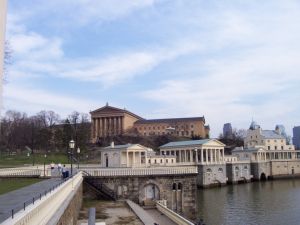 |
| THE FAIRE MOUNT |
Although the Art Museum now dominates the end of the Benjamin Franklin Parkway, the earlier focus of the acropolis once called Fair Mount is just down the hill behind it, in the old Grecian complex of the Philadelphia waterworks. When the Schuylkill was dammed at that point, the effect was to calm the rapids, drown the falls at Midvale Avenue upstream, and turn this portion of the river into a placid fresh-water lake. Fairmont Park was then created upstream in an effort (originally stimulated by the College of Physicians of Philadelphia) to reduce pollution of Philadelphia's water supply going into the pumps at the Waterworks, by replacing, with parkland, the wards, and industrial slums at the terminus of the canal bringing anthracite from upstate. The result was the creation of an ideal place for public boating and skating.
The transformation of this area can be seen in retrospect as an impressive civic response to economic upheaval. The War of 1812 (by cutting off ocean access to bituminous via the Chesapeake) had first forced Philadelphia to use anthracite hard coal, and the discovery of anthracite's superiority in making steel caused a continuing reliance on it and the canals
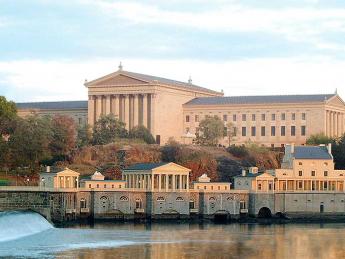
|
| Philadelphia's Water Works |
that brought it here. By 1850, the Philadelphia and Reading Railroad made the canals obsolete and created this splendid opportunity for urban renewal. The waterfalls had created a natural boundary between industry oriented to upstate coal and other industry oriented to oil and commerce coming up Delaware. It is a great pity that the lower section of the Schuylkill, once so famously beautiful, has never stimulated the same vision and imagination in response to the eventual decline of the industrialization which defaced it.
To return to Boathouse Row, a large azalea garden starts the Park, and then the East River Driver winds along the attractively landscaped riverbank. Just beyond the azalea garden, the first of ten Victorian-style boathouses starts the home of the Schuylkill Navy, an association of rowing clubs which are now a century and a half in residence there. When the Schuylkill auto expressway was created on the other side of the river, someone had the bright idea of decorating the rowing houses with lights along their edges in the manner used for Christmas decorations in South Philadelphia, especially on Smedley and Colorado Streets. Ever since the entrance to Philadelphia from the West has become one of its most arresting beauties.
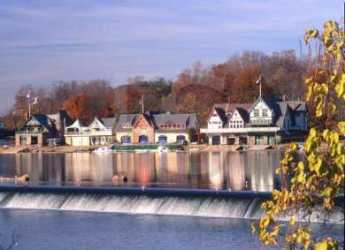 |
| BOATHOUSE ROW |
Add a few cherry blossom trees in the spring, and you have quite a memorable centerpiece. Rowing sometimes called crewing, or sculling, is a central focus of Philadelphia society, and is curiously not something in which the city can claim to be first or the oldest. As you might expect, "regatta" is a word invented in Venice five hundred years ago, there are records of rowing races as far back as 400 BC, and New York -- ye Gods! -- had the first American boating club. The Philadelphia Schuylkill Navy was formed as an association of rowing clubs in 1858, and the oldest member, the Bachelor's Barge, was only formed in 1856. The development was largely spontaneous and is said to have been briskly stimulated by a beer garden nearby, run by a former Philadelphia sheriff. About the same time, the British became crazy about the sport, having the Henley Races as the most famous regatta in the world, and both the Australians and the Bostonians occasionally have the largest, most expensive, most widely advertised regattas. Foo. Philadelphia has the Schuylkill Navy, and it is central to our existence.
There are a couple of things which are unique about rowing. In the first place, it is hard to think of a way to cheat. You can hire engineers to redesign the shape and size of your boat, but engineering really doesn't make a lot of difference once the basic development of oarlocks and movable seats was perfected. A good boat can cost as much as $30,000, but that is large because all boats approach the limit of speed. If you have heavier or stronger oarsmen, it doesn't make that much difference. What matters is coordination, and in the longer boats, teamwork. Pull up with your shoulders, push with your legs, don't start with your buttocks, the art of rowing involves your whole body. The greatest champion of all time, Edward "Ned" Hanlan,
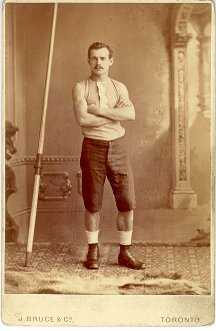 |
| EDWARD HANLAN |
only weighed 155 pounds. Not only was he world champion from 1876 to 1884, he was undefeated in any race during the last four years. True, he was born in Toronto, and eventually he was thrown out of polite Philadelphia racing for deliberately ramming another boat, but those are private Philadelphia comments, not something you want to talk too much about. The whole secret of rowing is to manage the fact that the boat travels farther between strokes than while the oars are in the water; if you row too fast, you actually slow the boat. There are two other Philadelphia names associated with the Schuylkill Navy. One is Thomas Eakins, the great American painter, one of whose most famous pictures is that of Max Schmitt in a Single Scull (on the Schuylkill). The other name is Kelly.
John B. Kelly of Philadelphia won two Olympic gold medals in 1920 and did it within one hour. He won a Third Olympic gold medal in 1924. But when he tried to race in the Henley Regatta, he was declared ineligible to row, because he had worked with his hands (summer work as a bricklayer), and thus could not really be called a gentleman. Anyone who has ever heard Irishmen talk about Englishmen can imagine the reaction this caused in the Kelly family. The resentment took the form of pushing his son, Jack, into racing, and in 1947 John B. Kelly, Jr. won the Diamond Sculls at Henley. Meanwhile, the father vindicated himself in other ways. The firm of Kelly for Brickwork was an enormous financial success, right up there next to Matthew H. McCloskey and John McShain, the political builders of the Pentagon and numerous other government buildings. John B. Kelly unsuccessfully ran for Mayor of Philadelphia in 1935 during the 75-year period when Philadelphia Mayors were always Republicans, but for decades was in the much more powerful position of head of the local Democratic party. The Republicans at that time would meet for lunch at the Union League, and so John Kelly reserved a lunch table at the Bellevue Hotel, next door, where he could be seen holding court every day.
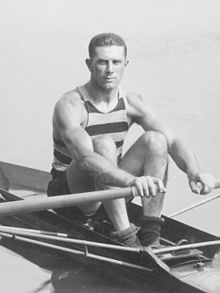
|
| John B Kelly |
The result was not entirely favorable for the Bellevue; more than one wedding reception was rescheduled to some other hotel in order to avoid the Democrat taint. But you always knew where you could find Kelly at lunch, and it was fun to watch the various minions come forward to the table, almost as if they were in chains, to pay homage which involved provoking loud laughter from the great man with a salacious joke. The rowing clubs are mostly big barns with old boats high up on the walls, and silver cups and wooden memorial plaques lower down. They have lockers and showers, but no dining rooms, except at catered in the evening for parties. For a century, no women came there, but now almost half of the rowers are female. Membership is not difficult to obtain, although you have to be good to get on the club teams, and the dues are not expensive. If you show promise, you are expected to spend most of your waking hours working at it. Jack Kelly was famous for rowing three hours every morning, going to lunch, and then coming back for a couple of hours of more rowing. That doesn't leave much time in your life for anything else, so the friendships developed among active club members are very strong, just like the horsemen over at the City Troop. They sort of life in the past a little, with many anecdotes about a skull that broke apart and sank in the midst of a race, or a race that was lost because of too much recreation the night before. The lingo has to do with the fine points. A race can be between "eights" or "fours", or doubles, or singles. It can have a coxswain, or not, and be coxed or unboxed. When a pair of rowers have two oars apiece, it is the normal arrangement. A much more difficult boat to control has two rowers, with one oar apiece. Like Hercules or Achilles, stories are told of Hanlan, great Hanlan, who sometimes would win a one-mile race by eleven lengths. Or who would get so far ahead of his competitors that he would lie down in the boat and wait for another boat to catch up -- and then race ahead to beat him. This sort of person can be a little hard to take, and it is privately muttered that Hanlan was sent off to Australia, where people do that sort of thing more commonly.
Originally published: Friday, June 23, 2006; most-recently modified: Wednesday, May 22, 2019
| Posted by: edward g keebler (lefty) | Oct 28, 2013 3:14 AM |
| Posted by: Nancy McGee | Apr 9, 2011 7:26 PM |